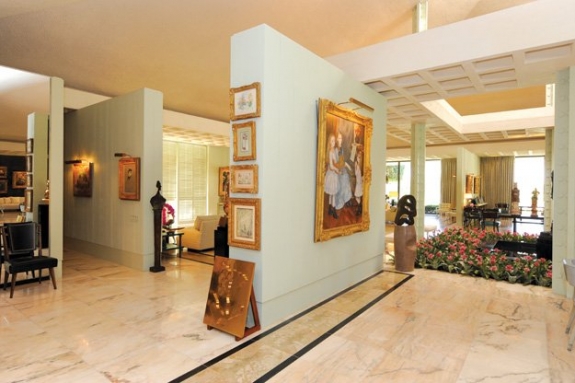Like many of the canvases in the Annenberg collection, Seated Peasant, an image Cézanne returned to time and again over four years in the 1890s to rework as he entered his most important phase, illustrates the collectors’ uncanny eye at acquiring the established works of an era, as well as the formative ones that shed light on artists’ processes and psyches more than major titles.
This particular acumen drew four major museums together for one year in 1990 in a game of one-upmanship, with the prize being 19th century Impressionist and 20th century post-Impressionist masterpieces. Twenty years ago last March, one of the art world’s most frenzied competitions came to a climactic end when Walter Annenberg announced he was bequeathing his more than $1 billion collection to the Metropolitan Museum of Art in New York.
Walter Annenberg began collecting in the late 1930s, but made some of his most ambitious acquisitions in the 1980s around the time he sold his publishing empire. At one point, he and his wife, Leonore, considered keeping the paintings at Sunnylands (their Rancho Mirage estate) or, briefly, auctioning them, but ultimately decided a larger institution would better suit the public.
The Met; Philadelphia Museum of Art; National Gallery of Art in Washington, D.C.; and Los Angeles County Museum of Art vied for the prize with intensity, although everyone remained coolly aloof on the surface. There was never a formal acknowledgement the paintings were available, but everybody knew the game was on.
What was at stake — it was unofficially dubbed the “Annenberg Stakes” — was arguably 52 of the most important European artworks and the single largest gift in a half-century to any museum. The Renoirs, Degases, Monets, and van Goghs that had hung at Sunnylands since the mid-1970s formed the foundation of the Annenbergs’ vast collection. Today, digital reproductions of all the paintings adorn the same places the Annenbergs hung the originals.
“There are certainly larger private collections,” says Richard Rand, senior curator at the Sterling and Francine Clark Art Institute in Williamstown, Mass., a museum founded on another great American collection of Impressionism. “But the Annenbergs have a certain number of signature pieces and other offbeat works that explain an artist really well. [The collection’s] mix is its strength.”
The collection did receive a little criticism. Some said, “It was too soft, not tough enough,” Rand recalls. By “soft,” critics meant the collection didn’t have enough of an edge and was missing some of the seminal images transitioning from Impressionism to post-Impressionism, establishing the ever-important bridge between the 19th century and modernism. But by the time the gift was made, the Annenbergs by chance had rectified such matters — at a price — with the purchase of two paintings.
In 1987, the Annenbergs spent $40.7 million at a Sotheby’s auction for Picasso’s 1905 At the Lapin Agile (Harlequin With a Glass) — a racy, jaundiced view of Parisian nightlife with his early Cubist leanings. At about the same time, they splurged on Braque’s pioneering 1939 The Studio. “Those really made a great collection monumental,” Rand says.
Their additions bolstered such paintings as Monet’s Camille Monet on a Garden Bench, a rousing plein-air rendering showcasing the artist’s early affinity with light and gardens; Wheat Field with Cypresses by van Gogh, the close relative of his famous The Starry Night; and Renoir’s sensuous Reclining Nude, an obsession during his peripatetic existence in the early 1880s. And there are still-life paintings from the obscure Henri Fantin-Latour, whom many Impressionists credited as an early inspiration.



